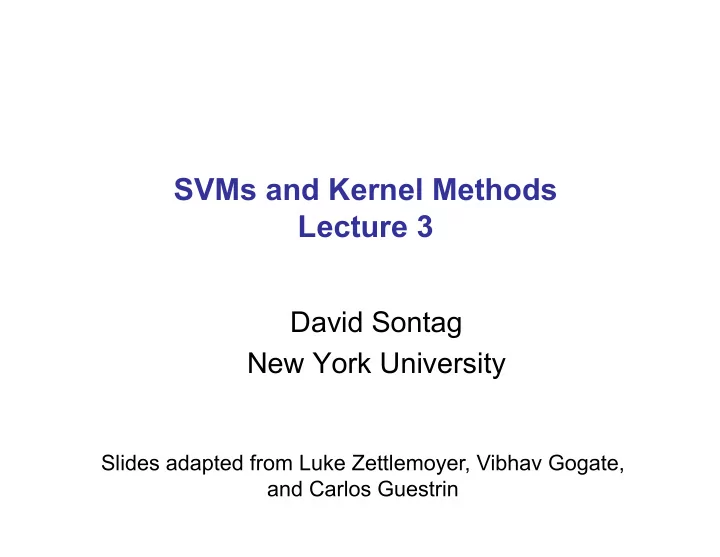

SVMs and Kernel Methods Lecture 3 David Sontag New York University Slides adapted from Luke Zettlemoyer, Vibhav Gogate, and Carlos Guestrin
Today’s lecture Dual form of soft-margin SVM Feature mappings & kernels Convexity, Mercer’s theorem (Time permitting) Extensions: Imbalanced data Multi-class Other loss functions L1 regularization
Recap of dual SVM derivation (Dual) ⇤ ⌅ Can solve for optimal w , b as function of α : ∂ L ⌥ ∂ w = w − α j y j x j j Substituting these values back in (and simplifying), we obtain: (Dual) So, in dual formulation we will solve for α directly! • w and b are computed from α (if needed)
Solving for the offset “b” Lagrangian: α j > 0 for some j implies constraint is tight. We use this to obtain b : (1) (2) (3)
Dual formulation only depends on dot-products of the features! First, we introduce a feature mapping : Next, replace the dot product with an equivalent kernel function: ~ ↵ ≥ 0 Do kernels need to be symmetric?
Classification rule using dual solution Using dual solution dot product of feature vectors of new example with support vectors Using a kernel function, predict with…
Dual SVM interpretation: Sparsity w . x + b = +1 w . x + b = 0 w . x + b = -1 Final solution tends to be sparse • α j =0 for most j • don’t need to store these points to compute w or make predictions Non-support Vectors: • α j =0 Support Vectors: • moving them will not • α j ≥ 0 change w
Soft-margin SVM Primal: Solve for w,b, α : Dual: What changed? • Added upper bound of C on α i ! • Intuitive explanation: • Without slack, α i ∞ when constraints are violated (points misclassified) • Upper bound of C limits the α i , so misclassifications are allowed
Common kernels • Polynomials of degree exactly d • Polynomials of degree up to d • Gaussian kernels • Sigmoid • And many others: very active area of research!
Polynomial kernel d =1 � u 1 � v 1 � ⇥ ⇥ � ⇥ ⇥ φ ( u ) . φ ( v ) = = u 1 v 1 + u 2 v 2 = u.v . u 2 v 2 u 2 v 2 ⇤ ⌅ ⇤ ⌅ d =2 ⌃ ⇧ ⌃ 1 1 u 1 u 2 v 1 v 2 ⌃ = u 2 1 v 2 1 + 2 u 1 v 1 u 2 v 2 + u 2 2 v 2 ⌥ � ⌥ � φ ( u ) . φ ( v ) = ⌃ . ⌥ � ⌥ � 2 u 2 u 1 v 2 v 1 ⇧ ⇧ = ( u 1 v 1 + u 2 v 2 ) 2 u 2 v 2 2 2 = ( u.v ) 2 For any d (we will skip proof): φ ( u ) . φ ( v ) = ( u.v ) d Polynomials of degree exactly d
Gaussian kernel Level sets, i.e. for some r w · φ ( x ) = r Support vectors [Cynthia Rudin] [mblondel.org]
Kernel algebra Q: How would you prove that the “Gaussian kernel” is a valid kernel? A: Expand the Euclidean norm as follows: To see that this is a kernel, use the Taylor series expansion of the Then, apply (e) from above exponential, together with repeated application of (a), (b), and (c): The feature mapping is infinite dimensional! [Justin Domke]
Overfitting? • Huge feature space with kernels: should we worry about overfitting? – SVM objective seeks a solution with large margin • Theory says that large margin leads to good generalization (we will see this in a couple of lectures) – But everything overfits sometimes!!! – Can control by: • Setting C • Choosing a better Kernel • Varying parameters of the Kernel (width of Gaussian, etc.)
How to deal with imbalanced data? • In many practical applications we may have imbalanced data sets • We may want errors to be equally distributed between the positive and negative classes • A slight modification to the SVM objective does the trick! Class-specific weighting of the slack variables
How do we do multi-class classification?
One versus all classification w + Learn 3 classifiers: w - • - vs {o,+}, weights w - • + vs {o,-}, weights w + • o vs {+,-}, weights w o w o Predict label using: Any problems? Could we learn this (1-D) dataset? -1 1 0
Multi-class SVM w + Simultaneously learn 3 sets of weights: w - • How do we guarantee the correct labels? w o • Need new constraints! The “score” of the correct class must be better than the “score” of wrong classes:
Multi-class SVM As for the SVM, we introduce slack variables and maximize margin: To predict, we use: Now can we learn it? -1 1 0 b + = − . 5
Recommend
More recommend